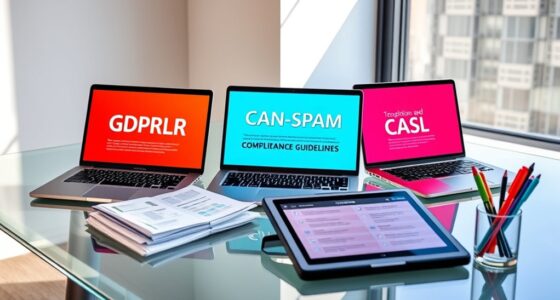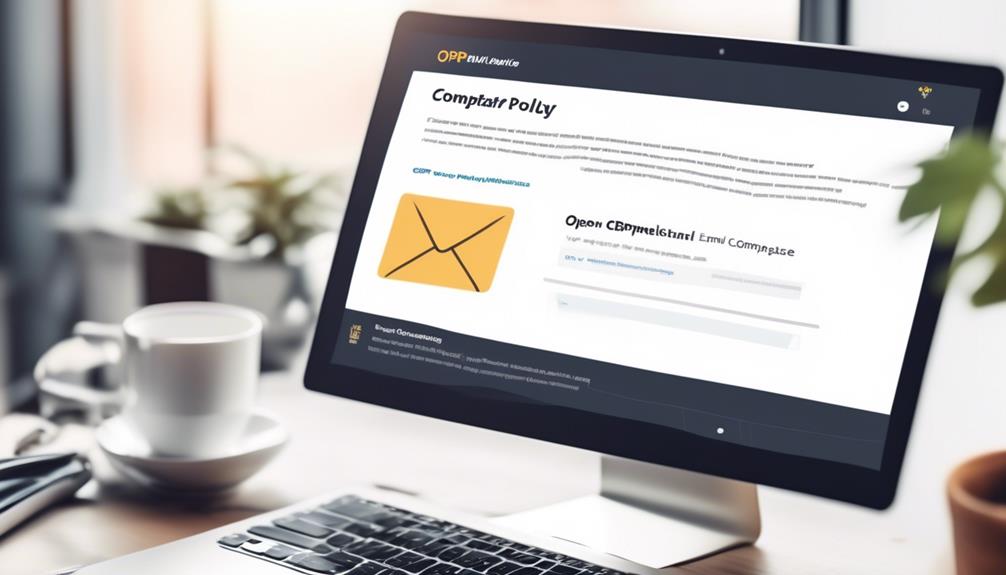Do you recall when email marketing was mainly focused on sending out bulk emails and hoping for a successful outcome?
Well, the GDPR has completely shaken things up, and we've had to adapt in some pretty significant ways.
From rethinking how we obtain consent to beefing up our data security measures, the changes have been substantial.
But what exactly are the three key shifts that have taken place, and how have they reshaped the way we approach email marketing?
Let's just say, it's been quite the journey, and the destination is definitely worth exploring.
Key Takeaways
- Obtaining explicit and informed consent is crucial for conducting email marketing activities under GDPR.
- Companies must prioritize data storage and protection, ensuring that personal data is securely stored and only retained when necessary.
- GDPR has necessitated a shift in how companies handle personal data for targeting and segmentation in email marketing, requiring a legal basis and clear information for data collection and usage.
- Compliance with GDPR, including the appointment of a Data Protection Officer, demonstrates a commitment to privacy and data security, fostering trust with customers.
Impact on Email Consent
Obtaining explicit and informed consent is a pivotal requirement for conducting email marketing activities under the General Data Protection Regulation (GDPR). This necessitates clear and specific actions to ensure compliance with the stringent consent standards.
GDPR has significantly impacted email marketing by placing a strong emphasis on obtaining explicit consent from individuals before processing their personal data for marketing purposes. This means that companies must ensure that the consent obtained is freely given, specific, informed, and unambiguous.
The information provided to individuals must be clear and transparent, detailing how their data will be used, stored, and shared. Additionally, GDPR prohibits the use of pre-ticked opt-in boxes or default options for consent. This requires individuals to take affirmative action to opt into receiving marketing communications.
As a result of GDPR, companies have had to reevaluate their email marketing practices to align with the new consent requirements. This includes reviewing and updating their consent mechanisms to ensure they meet the standards set forth by the regulation.
Furthermore, companies need to be mindful of data subject rights, including the right to withdraw consent at any time. Overall, the impact of GDPR on email consent has compelled organizations to prioritize data privacy and security while conducting email marketing activities.
Data Storage and Protection

Under the General Data Protection Regulation (GDPR), companies are required to diligently safeguard and securely store customers' personal data, implementing stringent measures to prevent unauthorized access or misuse. Compliance with GDPR necessitates that businesses only retain necessary personal data and delete it when it's no longer required. This regulation also mandates the appointment of a Data Protection Officer (DPO) to ensure and oversee compliance.
In the context of email marketing, GDPR's impact on data storage and protection is significant. Marketers must ensure that the personal data collected for email marketing purposes is stored securely and used in a manner consistent with the regulation. Moreover, in the event of a data breach, GDPR requires that companies report the breach to the relevant authorities within 72 hours. This emphasizes the critical importance of implementing robust security measures to safeguard customer data.
Adhering to GDPR's data storage and protection requirements not only ensures compliance but also demonstrates a commitment to privacy and data security, ultimately fostering trust with customers.
Changes in Targeting and Segmentation
In light of the General Data Protection Regulation (GDPR), our approach to targeting and segmentation has undergone significant changes, necessitating a meticulous review of how we collect, store, and utilize personal data for these purposes.
The GDPR has necessitated a shift in how companies handle personal data for targeting and segmentation in email marketing. Companies are now required to have a legal basis, such as explicit consent, for processing personal data for these purposes. Moreover, they must ensure that they only collect necessary data and use it for compatible purposes. Additionally, clear and concise information about data collection and usage must be provided to customers, ensuring transparency and accountability in segmentation and targeting practices.
As a result, email marketing tactics have evolved to prioritize consent-based targeting and segmentation, ensuring that the processing of personal data complies with GDPR regulations. This shift not only aligns with the GDPR's requirements but also demonstrates our commitment to respecting the privacy and data protection rights of EU citizens.
As we navigate these changes, our Data Protection Officer plays a crucial role in overseeing and ensuring compliance with GDPR regulations in our targeting and segmentation practices. Furthermore, including an easily accessible unsubscribe link in our emails further emphasizes our commitment to respecting individuals' rights and preferences regarding their personal data.
Frequently Asked Questions
What Has GDPR Resulted in for Email Marketing?
GDPR has resulted in stricter rules for obtaining consent for email marketing, requiring explicit and informed consent from subscribers. Companies are now required to implement enhanced data storage and protection measures to ensure the security of customers' personal data.
The GDPR has led to significant changes in how companies approach segmentation and targeting for email marketing, emphasizing the need for a legal basis and transparent data usage.
Email marketing tactics under GDPR now require clear opt-in and opt-out mechanisms, prohibiting pre-ticked boxes and default options for consent.
What Are the Key Changes of Gdpr?
We acknowledge the key changes brought about by GDPR, including stricter consent requirements, revised rules for data handling, and the mandatory appointment of a Data Protection Officer.
We've adapted our email marketing tactics to ensure compliance with these changes, prioritizing explicit, informed, and freely given consent.
We've also adjusted our data collection, storage, and usage practices to align with GDPR's guidelines, emphasizing responsible and compliant segmentation and targeting.
What Are the Three Main Goals of the Gdpr?
The three main goals of the GDPR are:
- To give EU citizens more control over their personal data.
- This reflects a commitment to data privacy and security.
- It ensures that individuals have a say in how their information is used.
- To require companies to obtain explicit consent before sending promotional emails.
- This goal aims to protect individuals from unsolicited and unwanted marketing messages.
- It empowers individuals to choose which communications they receive.
- To mandate the protection and secure storage of customer data.
- This goal ensures that companies handle customer data responsibly and protect it from breaches or unauthorized access.
- It holds companies accountable for the secure handling of personal information.
These three goals work together to enhance data privacy, empower individuals, and promote responsible data handling by companies.
How Does GDPR Affect Emails?
GDPR significantly impacts email marketing by requiring explicit consent for sending promotional emails and newsletters. Companies must prioritize data protection and secure storage, utilizing opt-ins and opt-outs to ensure compliance.
GDPR has transformed how personal data is collected, stored, and used for segmentation and targeting. To adhere to GDPR, businesses need to conduct privacy impact assessments, strengthen consent mechanisms, and ensure transparency in their email marketing practices.
What are the key changes that GDPR has brought to email marketing tactics?
The reasons for GDPR impact on email marketing tactics are numerous. Marketers now need explicit consent to send promotional emails, and individuals have more control over their personal data. This has led to a shift towards permission-based marketing and greater emphasis on data protection and privacy compliance.
Conclusion
In conclusion, the GDPR has truly transformed email marketing tactics, like a gust of wind reshaping a landscape.
With stricter consent requirements, enhanced data protection measures, and changes in targeting and segmentation, businesses must adapt to prioritize customer consent and data security.
It's an evolving landscape, but by embracing these changes, companies can build trust with their customers and ensure compliance with the new regulations.








